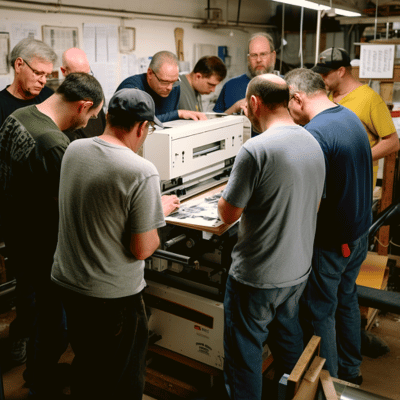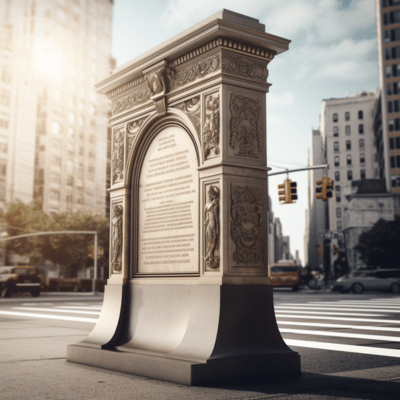The world of architecture is ever-evolving, and one area that continues to gain prominence is custom signs for architects. These signs not only create a unique visual identity for a brand, but also serve as functional elements that guide visitors and enhance user experience. In this blog post, we will delve into the art of custom architectural signs, the role of architects in their design, key considerations, and the latest trends in the industry. Get ready to explore the fascinating world of custom signs for architects and how they bring architecture to life!
Short Summary
- Custom architectural signs are essential for creating an impactful first impression and helping businesses stand out.
- Architects must consider aesthetics, functionality, trends, materials selection, sign placement & visibility when designing custom signage to ensure a seamlessly integrated result that is both visually pleasing and functionally efficient.
- Latest insights in custom architectural signage include social & eco-consciousness, minimalism, nostalgia/vintage influences, natural influences, sustainability with increased usage of digital signage & curved designs with modern minimalist aesthetics.
The Art of Custom Architectural Signs for Architects

Custom architectural signs play a crucial role in creating a positive first impression and helping businesses stand out in today’s competitive landscape. They are used in various industries and can range from monument signs to environmental graphics, all tailored to suit a specific brand and architectural design. Signmakers.com, for instance, offers professional sign solutions such as new signs, large installations, scale graphics, glass decals, digital displays, and distinctive branding to architects and engineering firms.
To create a successful custom architectural sign, architects need to strike a balance between aesthetics and functionality while incorporating the latest trends and materials. With a well-designed sign, businesses can elevate their brand, create a lasting impression, and enhance the overall user experience.
In the following sections, we will explore the architect’s role in signage design, key considerations for custom signs, and the latest insights in the industry.
The Architect’s Role in Signage Design
Architects play a pivotal role in designing custom signage that harmonizes with a building’s overall design. They collaborate with signage designers to ensure that the signage is functional, safe, sustainable, and aesthetically pleasing while also serving as a wayfinding and identification tool within a facility or campus. To achieve this, architects consider elements such as material selection, sign placement and visibility, and compliance with applicable codes and regulations.
With a keen eye for aesthetics and functionality, architects can create custom signs that not only stand out but also serve their intended purpose effectively. By balancing these two key elements, they can ensure that the signage is visually appealing and built to last, ultimately enhancing the overall user experience.
Balancing Aesthetics and Functionality
When designing custom architectural signage, architects must prioritize functionality without compromising on aesthetics. The sign must be able to convey its message effectively while blending seamlessly with the building’s design. This involves considering dimensions, form, and material, as well as the discernibility and legibility of the sign.
To achieve a balance between aesthetics and functionality, architects must ensure that the sign is proportionate to its surroundings and that design elements are balanced. Moreover, clear communication of design intent is vital, guaranteeing that the sign is legible and comprehensible to its target audience.
In essence, a well-designed sign should be both visually captivating and functionally efficient, providing a seamless integration with the architectural environment.
Key Considerations for Custom Architectural Signage

When embarking on a custom architectural signage project, there are several key considerations to keep in mind. These include material selection, sign placement and visibility, and compliance with codes and regulations. By addressing these aspects, architects can ensure that their custom signs are not only visually appealing but also functional, durable, and in line with legal requirements.
In the following subsections, we will explore each of these considerations in detail, providing insights into how architects can make informed decisions when designing custom architectural signs. This knowledge will prove invaluable in creating signage that effectively meets the needs of both the client and the end-users.
Material Selection
Selecting the right materials for custom architectural signage is crucial, as it directly impacts the sign’s durability, aesthetics, cost, and suitability for its intended environment. Architects must consider factors such as the sign’s location, expected lifespan, and overall design when choosing materials.
Some commonly used materials include aluminum, acrylic, polycarbonate, stone, brick, wood, and concrete, each offering unique benefits and drawbacks. By carefully considering the various factors and selecting the most suitable materials, architects can create custom signs that not only look great but are also built to withstand the test of time.
Sign Placement and Visibility
Sign placement and visibility are essential considerations in custom architectural signage design. The sign must be both visible and legible from the desired viewing distance, considering factors such as size and height, location, traffic flow, and pedestrian access. Additionally, the sign should be easily visible from nearby streets and highways, with good contrast and legibility.
By carefully planning the placement and visibility of custom signs, architects can ensure that their signage effectively communicates its intended message and enhances the overall user experience. This involves selecting the appropriate size, height, and location, as well as taking into account traffic flow and pedestrian access to create a sign that truly stands out.
Compliance with Codes and Regulations
Compliance with codes and regulations is a critical consideration in custom architectural signage design. This includes adhering to the Americans with Disabilities Act (ADA) regulations, which involve the use of Grade II Braille and meeting specific requirements for dot base diameter.
Architects must be well-versed in the relevant codes and regulations to ensure that their custom signs are compliant. This not only guarantees that the signage is safe and accessible for all users, but also helps avoid potential legal issues or costly modifications down the line.
By keeping compliance at the forefront of the design process, architects can create custom signs that are both visually appealing and legally compliant.
Monument Signs: Making a Bold Statement

Monument signs are an excellent way to make a bold statement for any business or organization. These large, free-standing signs are designed to be highly weather-resistant, sitting close to the ground level and built to be solid and long-lasting. They can be constructed from various materials, including concrete, metal cabinets, and armored foam with a stucco finish, offering durability and a striking visual impact.
In the following subsections, we will delve into the process of designing monument signs, discussing material choices and their durability. This information will provide architects with valuable insights into creating monument signs that effectively capture attention and convey a powerful message.
Designing Monument Signs
When designing monument signs, architects must consider the purpose and objectives of the sign, as well as factors such as location, size, shape, color, font, and placement. The sign should be an extension of the building and property, ensuring that it stands out and is easily noticed. Moreover, durability should be a priority, as monument signs are designed to withstand the elements and remain visually appealing for years to come.
By taking these factors into account and working closely with signage designers, architects can create monument signs that not only make a bold statement but also stand the test of time. These signs can greatly enhance the visual identity of a brand, creating a lasting impression on visitors and passersby alike.
Material Choices and Durability
Material choice is crucial when it comes to the durability and longevity of monument signs. Some common materials used in their construction include aluminum, acrylic, polycarbonate, stone, brick, wood, and concrete, each with its unique benefits and drawbacks. For instance, aluminum is a popular choice due to its robustness and resistance to corrosion, while acrylic and polycarbonate offer weather-resistance and durability.
When selecting materials for monument signs, architects must consider factors such as the sign’s intended environment, desired aesthetics, and budget. By carefully weighing these factors and selecting the most suitable materials, architects can create monument signs that are not only visually appealing but also built to last and withstand the elements.
Environmental Graphics: Enhancing Spaces with Custom Signs

Environmental graphics, also known as environmental graphic design (EGD), is a multidisciplinary field that incorporates graphic elements such as typography, color, imagery, and textures to improve the user experience in the built environment. These custom signs can create a personalized and unforgettable experience for visitors, helping to establish a sense of belonging, guide navigation, and communicate a message. Examples of environmental graphics include wayfinding and placemaking systems for entities like transportation utilities, hospitals, universities, and shopping malls.
In the following subsections, we will explore the different types of environmental graphics available and discuss how architects can incorporate these custom signs into their designs. By understanding the various options and their applications, architects can create spaces that are not only visually engaging but also highly functional and user-friendly.
Types of Environmental Graphics
There are several types of environmental graphics available, each offering unique benefits and applications. These include branded environments, signage and wayfinding, walls and glass graphics, interactive media, and social media. Branded environments showcase the values and identity of a company or organization, while signage and wayfinding systems assist individuals in navigating within a space. Walls and glass graphics, on the other hand, enhance the aesthetics of a space through wall murals, window graphics, and other decorative elements.
Understanding the various types of environmental graphics enables architects to make informed decisions when incorporating custom signs into their designs. By selecting the most suitable options for a specific project, architects can create spaces that are visually engaging and highly functional, ultimately enhancing the user experience.
Incorporating Environmental Graphics into Architectural Design
To effectively incorporate environmental graphics into architectural design, architects must consider factors such as typography, color, imagery, and textures, as well as the overall design and layout of the space. Additionally, architects need to ensure that the graphics are integrated seamlessly into the overall design, providing visibility, readability, and durability, all while conveying the intended story or message.
By taking these factors into account and working closely with signage designers, architects can incorporate environmental graphics into their designs in a way that enhances the overall user experience. Whether it’s through wayfinding signage, wall murals, or dimensional lettering, custom signs can bring a space to life and create a lasting impression on visitors.
Collaborating with General Contractors and Sign Manufacturers
Collaborating with general contractors and sign manufacturers is essential when designing custom architectural signage. It ensures that the signage is of superior quality and complies with all applicable codes and regulations, as well as being in line with the entire building’s design. Moreover, it is important to create a signage plan to assist the general contractor and owner in visualizing the uses and locations of the signage.
In the following subsections, we will delve into the importance of communication and establishing clear expectations when collaborating with general contractors and sign manufacturers, as well as how to ensure quality and consistency in custom architectural signage projects.
The Importance of Communication
Clear and concise communication is vital when collaborating with general contractors and sign manufacturers to ensure that all involved parties understand the project requirements and prevent any miscommunications or misunderstandings that could result in delays or other issues. Utilizing technology such as video conferencing, online project management tools, and digital communication tools can assist in enhancing collaboration.
Moreover, identifying communication channels such as email, phone, or text can facilitate ensuring that all parties are able to communicate in a timely manner. Additionally, establishing a timeline and defining expectations for deliverables is essential to ensure that all stakeholders involved are informed of the project requirements and deadlines. This helps guarantee that the project is completed in a timely manner and to the satisfaction of all stakeholders.
Ensuring Quality and Consistency
To ensure quality and consistency in custom architectural signage projects, it is important to establish clear communication channels and expectations with general contractors and sign manufacturers. This can help prevent miscommunication and ensure that all parties are aware of their respective obligations. Defining a clear scope of work and quality standards for the project is also essential to prevent potential misunderstandings and ensure that all parties involved are aware of the expectations.
Promoting collaboration and using collaborative technology can also help enhance the overall quality and consistency of the project. By working closely with general contractors and sign manufacturers, architects can ensure that their custom architectural signs are not only visually appealing but also meet the highest standards of quality and compliance.
Latest Insights: Trends in Custom Architectural Signage

Keeping up with the latest trends in custom architectural signage is essential for architects who want to stay ahead of the curve and create cutting-edge designs. Some of the current trends include social and eco-consciousness, minimalism, nostalgia and vintage influences, natural influences, sustainability, increased usage of digital signage, and curved designs. There is also a preference for modern and minimalist aesthetics, as well as the incorporation of sustainable materials and practices, such as recycled materials, energy-efficient lighting, and water-based inks.
Additionally, digital signage and interactive displays are gaining popularity, with custom architectural signage increasingly utilizing LED displays, interactive kiosks, and digital signage software to create engaging and dynamic experiences for users. In the following subsections, we will explore these latest insights and trends in more detail, providing valuable insights for architects looking to create innovative and future-ready custom signs.
Sustainable Materials and Practices
Sustainable materials and practices are becoming increasingly important in custom architectural signage, with architects seeking to minimize the environmental impact of their designs. This involves utilizing recycled or renewable materials, minimizing waste and energy consumption during production and installation, and optimizing the potential of the site. Some measures to maximize site potential through sustainable materials and practices include utilizing materials sourced locally to reduce transportation and energy consumption and incorporating materials designed for long-term use.
By embracing sustainable materials and practices, architects can create custom signs that not only look great, but also contribute to a greener and more eco-friendly future. This approach is not only beneficial for the environment, but can also enhance the reputation of a brand and appeal to an increasingly eco-conscious audience.
Digital Signage and Interactive Displays
Digital signage and interactive displays are transforming the world of custom architectural signage, offering new and exciting ways for architects to engage with their audience. These digital displays can be used to present text, images, videos, and other multimedia content, providing a dynamic and interactive experience for users. When designing digital signage and interactive displays, architects must consider factors such as reliability, durability, image quality, accessibility, and user experience.
Some examples of digital signage and interactive displays include LCD and LED displays, projection systems, interactive kiosks, and touchscreens. By incorporating these cutting-edge technologies into their custom architectural signage designs, architects can create immersive and engaging spaces that captivate audiences and elevate the overall user experience.
Summary
In conclusion, custom architectural signs offer architects a unique opportunity to create visually captivating and functional designs that enhance the user experience. By striking a balance between aesthetics and functionality, considering key factors such as material selection, sign placement, and compliance, and staying up-to-date with the latest trends and technologies, architects can create custom signs that not only make a bold statement but also stand the test of time. So, as you embark on your next custom architectural signage project, remember to keep these insights in mind and let your creativity soar!


